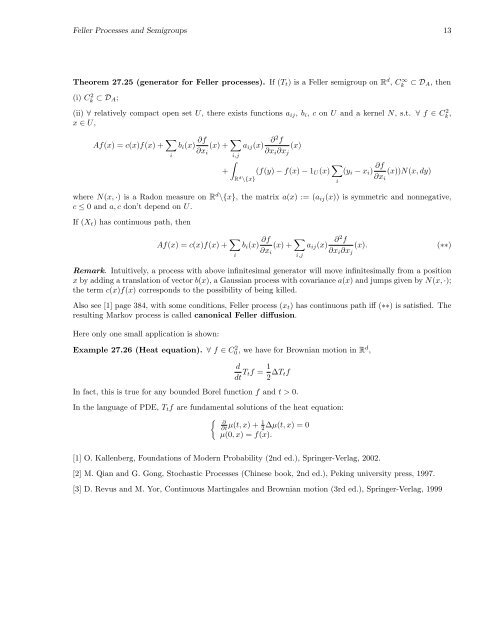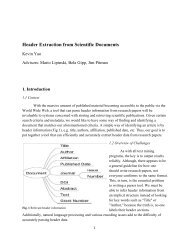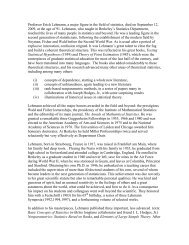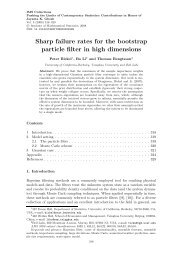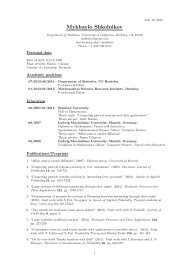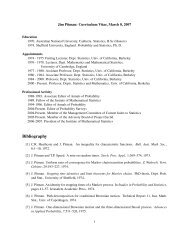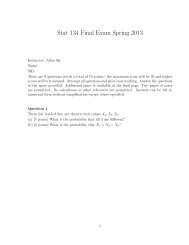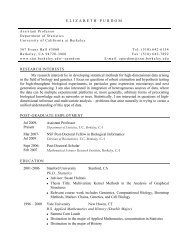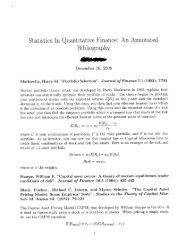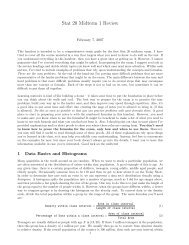Feller Processes and Semigroups
Feller Processes and Semigroups
Feller Processes and Semigroups
You also want an ePaper? Increase the reach of your titles
YUMPU automatically turns print PDFs into web optimized ePapers that Google loves.
<strong>Feller</strong> <strong>Processes</strong> <strong>and</strong> <strong>Semigroups</strong> 13<br />
Theorem 27.25 (generator for <strong>Feller</strong> processes). If (T t ) is a <strong>Feller</strong> semigroup on R d , C ∞ k<br />
(i) C 2 k ⊂ D A;<br />
⊂ D A, then<br />
(ii) ∀ relatively compact open set U, there exists functions a ij , b i , c on U <strong>and</strong> a kernel N, s.t. ∀ f ∈ C 2 k ,<br />
x ∈ U,<br />
Af(x) = c(x)f(x) + ∑ i<br />
b i (x) ∂f (x) + ∑ ∂ 2 f<br />
a ij (x) (x)<br />
∂x i ∂x<br />
i,j<br />
i ∂x j<br />
∫<br />
+<br />
− f(x) − 1 U (x)<br />
R \{x}(f(y) ∑<br />
d i<br />
(y i − x i ) ∂f<br />
∂x i<br />
(x))N(x, dy)<br />
where N(x, ·) is a Radon measure on R d \{x}, the matrix a(x) := (a ij (x)) is symmetric <strong>and</strong> nonnegative,<br />
c ≤ 0 <strong>and</strong> a, c don’t depend on U.<br />
If (X t ) has continuous path, then<br />
Af(x) = c(x)f(x) + ∑ i<br />
b i (x) ∂f<br />
∂x i<br />
(x) + ∑ i,j<br />
∂ 2 f<br />
a ij (x) (x).<br />
∂x i ∂x j<br />
(∗∗)<br />
Remark. Intuitively, a process with above infinitesimal generator will move infinitesimally from a position<br />
x by adding a translation of vector b(x), a Gaussian process with covariance a(x) <strong>and</strong> jumps given by N(x, ·);<br />
the term c(x)f(x) corresponds to the possibility of being killed.<br />
Also see [1] page 384, with some conditions, <strong>Feller</strong> process (x t ) has continuous path iff (∗∗) is satisfied. The<br />
resulting Markov process is called canonical <strong>Feller</strong> diffusion.<br />
Here only one small application is shown:<br />
Example 27.26 (Heat equation). ∀ f ∈ C 2 0, we have for Brownian motion in R d ,<br />
d<br />
dt T tf = 1 2 ∆T tf<br />
In fact, this is true for any bounded Borel function f <strong>and</strong> t > 0.<br />
In the language of PDE, T t f are fundamental solutions of the heat equation:<br />
{ ∂<br />
∂t µ(t, x) + 1 2∆µ(t, x) = 0<br />
µ(0, x) = f(x).<br />
[1] O. Kallenberg, Foundations of Modern Probability (2nd ed.), Springer-Verlag, 2002.<br />
[2] M. Qian <strong>and</strong> G. Gong, Stochastic <strong>Processes</strong> (Chinese book, 2nd ed.), Peking university press, 1997.<br />
[3] D. Revus <strong>and</strong> M. Yor, Continuous Martingales <strong>and</strong> Brownian motion (3rd ed.), Springer-Verlag, 1999


